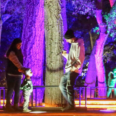
Extreme drought conditions have been prevalent across the San Gabriel Valley for years and now new research suggests that as the drought intensifies, the percentage of infected West Nile mosquitoes goes up.
A steady rise in infected mosquitoes in the Pasadena area has been documented since 2019.
Data provided by San Gabriel Valley Mosquito and Vector Control District (SGVMVCD) revealed that a total of 17 mosquito samples from San Gabriel Valley tested positive for WNV in 2019, 53 samples tested positive in 2020 while 190 samples tested positive in 2021.
This counterintuitive relationship between less water and more West Nile virus-carrying mosquitoes was described in 2017 by scientists who studied the relationship between climate change and the virus.
One of them, Sara Paull, a disease ecologist at the National Ecological Observatory Network in Boulder, Colorado, told Kaiser Health News the connection may have to do with birds.
Mosquitoes pick up the virus from infected birds before spreading it to humans. When the water supply is limited, birds congregate in greater numbers around water sources, making them easier targets for mosquitoes, according to KHN.
A key factor in these studies is the so-called “Goldilocks temperature,” which is described as the “sweet spot” temperature range most conducive for mosquitoes to spread a virus.
“San Gabriel Valley, which includes Pasadena, experiences the ‘Goldilocks temperature’ range regularly year-round,” observed SGVMVCD communications director Levy Sun.
“Any time we experience multiple nights with lows higher than 57 degrees Fahrenheit and multiple daytime temperatures between 75-80 degrees Fahrenheit, we can expect West Nile virus to circulate more quickly between the birds and mosquitoes.”
West Nile Virus is spread by the local Culex mosquitoes. The virus survives in nature in several types of birds and is transmitted by the bites of mosquitoes that feed on infected birds.
According to Sun, generally any changes in climate can impact mosquitoes’ behavior and the ability for West Nile Virus to spread.
But interestingly, the increase in the number of infected mosquitoes has not translated into an increase in human cases of the virus in the state.
In 2019, 29 WNV human cases have been reported in California, 93 cases have been reported in 2020 and 17 cases have been reported in 2021. There are no widely-known studies of the effect of the pandemic upon West Nile Virus infection rates.
Despite the impact of weather changes on mosquito activities, Sun said data to conclude that climate change determines transmission rates are lacking.
In July, SGVMVCD confirmed the detection of West Nile virus in Pasadena for the first time in three years.
“The biggest influence on mosquitoes and West Nile virus is people’s habits around their homes. Stagnant water is a constant norm in many yards even through drought years. That contributes to a consistent creation of mosquitoes inundating neighborhoods,” Sun said.
No human vaccine exists for West Nile virus, he said.
Besides removing stagnant water, Sun said the best defense against mosquitoes is using insect repellent applied directly to all exposed skin.
He also advised the public to remove dense vegetation from yards and patios to stop mosquitoes from hiding from the hot weather.



















